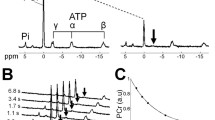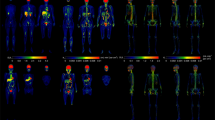Abstract
Purpose
The purpose of the present study is to apply kinetic analysis to investigate exercise-related changes in the metabolism of the skeletal muscle of the rat hindlimb by [\({}^{11}\hbox {C}\)]acetate positron emission tomography and computed tomography (PET/CT).
Methods
Contractions were induced in Wistar rats’ left hindlimb by electrostimulation of the Vastus Lateralis muscle motor point. After 15 min of muscle contractions, [\({}^{11}\hbox {C}\)]acetate was injected and PET/CT of both hindlimbs was acquired. The resting hindlimb was used as a control reference. The kinetic parameters \(K_1\) and \(k_2\) were calculated for the target muscles (exercised and control) and correlated with the corresponding standardized uptake values (SUVs). The ratio between each kinetic parameter values and the SUV extracted for the exercised muscle and the muscle at rest was computed (\(K_1^{Ex}/K_1^{Re},\, k_2^{Ex}/k_2^{Re}\) and \(\hbox {SUV}^{Ex}/\hbox {SUV}^{Re}\), respectively).
Results
Kinetic analysis quantitatively confirmed that net tracer uptake (\(K_1\)) and washout (\(k_2\)) were significantly higher in exercised muscles (\(K_1: \,0.34 \pm 0.12 \hbox { min}^{-1}\) for exercised muscles vs. \(0.18 \pm 0.09\hbox { min}^{-1}\) for resting muscles, \(P=0.01\); \(k_2:\, 0.22 \pm 0.05\hbox { min}^{-1}\) for exercised muscle vs. \(0.14 \pm 0.04 \hbox { min}^{-1}\) for resting muscle, \(P=0.002\)). On the other hand, SUV was not significantly different between active and inactive muscles (\(0.7 \pm 0.2\) for exercised muscles vs. \(0.6 \pm 0.1\) for resting muscles). Linear regression analysis revealed a good correlation (\(R^2=0.75,\, P=0.005\)) between net tracer uptake ratio (\(K_1^{Ex}/K_1^{Re}\)) and the SUV ratio \((\hbox {SUV}^{Ex}/\hbox {SUV}^{Re}\)). A lower correlation was found between the net tracer washout ratio (\(k_2^{Ex}/k_2^{Re}\)) and the SUV ratio (\(R^2=0.37,\, P=0.1\)).
Conclusion
The present study showed that kinetic modelling can detect changes between active and inactive skeletal muscles with a higher sensitivity with respect to the SUV, when performed with [\({}^{11}\hbox {C}\)]acetate PET/CT.







Similar content being viewed by others
Notes
This approach is generally preferred in patients, because of the invasiveness of arterial sampling. However, these methods may offer limited accuracy, require complex correcting factors and lack the necessary temporal resolution.
Moreover, clinically feasible model-fitting algorithm have recently been applied on whole-body dynamic PET human studies [24]
References
Armbrecht JJ, Buxton DB, Schelbert HR (1990) Validation of [1-11C]acetate as a tracer for noninvasive assessment of oxidative metabolism with positron emission tomography in normal, ischemic, postischemic, and hyperemic canine myocardium. Circulation 81:1594–1605
Bentourkia M, Croteau T, Langlois R, Aliaga A, Cadorette J, Benard F, Lesur O, Lecomte R (2002) Cardiac studies in rats with 11C-acetate and PET: a comparison with 13N-ammonia. IEEE Trans Nucl Sci 49:231–238
Boellaard R, Knaapen P, Rijbroek A, Luurtsema GJJ, Lammertsma AA (2005) Evaluation of basis function and linear least squares methods for generating parametric blood flow images using 15O-water and positron emission tomography. Mol Imaging Biol 7:273–285
Buchegger F, Ratib O, Willi JP, Steiner C, Seimbille Y, Zaidi H, Graf V, Peter R, Jung M (2011) [11C]acetate PET/CT visualizes skeletal muscle exercise participation, impaired function, and recovery after hip arthroplasty; first results. Mol Imaging Biol 13:793–799
Buck A, Wolpers HG, Hutchins GD, Savas V, Mangner TJ, Nguyen N, Schwaiger M (1991) Effect of carbon-11-acetate recirculation on estimates of myocardial oxygen consumption by PET. J Nucl Med 32:1950–1957
Convert L, Morin-Brassard G, Cadorette J, Archambault M, Bentourkia M, Lecomte R (2007) A new tool for molecular imaging: the microvolumetric \(\beta \) blood counter. J Nucl Med 48:1197–1206. doi:10.2967/jnumed.107.042606
Convert L, Morin-Brassard G, Cadorette J, Rouleau D, Croteau E, Archambault M, Fontaine R, Lecomte R (2007) A microvolumetric \(\beta \) blood counter for pharmacokinetic PET studies in small animals. IEEE Trans Nucl Sci 54(1):173–180
Croteau E, Gascon S, Bentourkia M, Langlois R, Rousseau JA, Lecomte R, Bénard F (2012) [11C]acetate rest-stress protocol to assess myocardial perfusion and oxygen consumption reserve in a model of congestive heart failure in rats. Nucl Med Biol 39:287–294
Croteau E, Lavallée E, Labbe SM, Hubert L, Pifferi F, Rousseau JA, Cunnane SC, Carpentier AC, Lecomte R, Bénard F (2010) Image-derived input function in dynamic human PET/CT: methodology and validation with 11C-acetate and 18F-fluorothioheptadecanoic acid in muscle and 18f-fluorodeoxyglucose in brain. Eur J Nucl Med Mol Imaging 37:1539–1550. doi:10.1007/s00259-010-1443-z
Diehl KH, Hull R, Morton D, Pfister R, Rabemampianina Y, Smith D, Vidal JM, van de Vortenbosch C (2001) A good practice guide to the administration of substances and removal of blood, including routes and volumes. J Appl Toxicol 21:15–23
Feng D, Wang Z, Huang S (1993) A study on statistically reliable and computationally efficient algorithms for generating local cerebral blood-flow parametric images with positron emission tomography. IEEE Trans Med Imaging 12:182–188
Germano G, Chen BJ, Huang SC, Gambhir SS, Hoffman EJ, Phelps ME (1992) Use of the abdominal aorta for arterial input function determination in hepatic and renal PET studies. J Nucl Med 33(6):613–620
van Hall G, Sacchetti M, Rådegran G (2002) Whole body and leg acetate kinetics at rest, during exercise and recovery in humans. J Physiol 542(1):263–272. doi:10.1113/jphysiol.2001.014340
Herrero P, Kim J, Sharp TL, Engelbach JA, Lewis JS, Gropler RJ, Welch MJ (2006) Assessment of myocardial blood flow using \({}^{15}\text{ O }\)-water and 1-\({}^{11}\text{ C }\)-acetate in rats with small-animal PET. J Nucl Med 47:477–485
van den Hoff J, Burchert W, Börner AR, Fricke H, Kühnel G, Meyer GJ, Otto D, Weckesser E, Wolpers HG, Knapp WH (2001) [1-11C]acetate as a quantitative perfusion tracer in myocardial PET. J Nucl Med 42:1174–1182
van den Hoff J, Burchert W, Müller-Schauenburg W, Meyer GJ, Hundeshagen H (1993) Accurate local blood flow measurements with dynamic PET: fast determination of input function delay and dispersion by multilinear minimization. J Nucl Med 34:1770–1777
van den Hoff J, Burchert W, Wolpers HG, Meyer GJ, Hundeshagen H (1996) A kinetic model for cardiac PET with [1-11C]acetate. J Nucl Med 37:521–529
Huang SC (2000) Anatomy of SUV. Nucl Med Biol 27:643–646
Huang SC, Wu HM, Shoghi-Jadid K, Stout DB, Chatziioannou A, Schelbert HR, Barrio JR (2004) Investigation of a new input function validation approach for dynamic mouse microPET studies. Mol Imaging Biol 6(1):34–46. doi:10.1016/j.mibio.2003.12.002
Ichihara K, Venkatasubramanian G, Abbas JJ, Jung R (2009) Neuromuscular electrical stimulation of the hindlimb muscles for movement therapy in a rodent model. J Neurosci Methods 176:213–224
Iida H, Kanno I, Miura S, Murakami M, Takahashi K, Uemura K (1986) Error analysis of a quantitative cerebral blood flow measurement using \(\text{ H }_2^{15}\text{ O }\) autoradiography and positron emission tomography, with respect to the dispersion of the input function. J Cereb Blood Flow Metab 6:536–545
Jung R, Belanger A, Kanchiku T, Fairchild M, Abbas JJ (2009) Neuromuscular stimulation therapy after incomplete spinal cord injury promotes recovery of interlimb coordination during locomotion. J Neural Eng 6(055010):1–14. doi:10.1088/1741-2560/6/5/055010
Kanchiku T, Kato Y, Suzuki H, Imajo Y, Yoshida Y, Moriya A, Taguchi T, Jung R (2012) Development of less invasive neuromuscular electrical stimulation model for motor therapy in rodents. J Spinal Cord Med 35(3):162–169. doi:10.1179/2045772312Y.0000000009
Karakatsanis NA et al (2013) Dynamic whole-body PET parametric imaging: I. Concept, acquisition protocol optimization and clinical application. Phys Med Biol 58:7391–7418
Kotzerke J, Volkmer BG, Neumaier B, Gschwend JE, Hautmann RE, Reske SN (2002) Carbon-11 acetate positron emission tomography can detect local recurrence of prostate cancer. Eur J Nucl Med Mol Imaging 29(10):1380–1384
Laforest R, Sharp TL, Engelbach JA (2005) Measurement of input functions in rodents: challenges and solutions. Nucl Med Biol 32:679–685
Lanz B, Poitry-Yamate C, Gruetter R (2014) Image-derived input function from the Vena Cava for 18F-FDG PET studies in rats and mice. J Nucl Med 55:1–9
Lapointe D, Cadorette J, Rodrigue S, Rouleau D, Lecomte R (1998) A microvolumetric blood counter/sampler for metabolic PET studies in small animals. IEEE Trans Nucl Sci 45(4):2195–2199
Magnenat-Thalmann N, Ratib O, Choi HF (2014) 3D multiscale physiological human. Springer, Berlin
Meyer PT, Circiumaru V, Cardi CA, Thomas DH, Bal H, Acton PD (2006) Simplified quantification of small animal [18F]FDG PET studies using a standard arterial input function. Eur J Nucl Med Mol Imaging 33:948–954
Ng CK, Huang SC, Schelbert HR, Buxton DB (1994) Validation of a model for [1-11C]acetate as a tracer of cardiac oxidative metabolism. Am J Physiol 266:H1304–H1315
Oyama N, Akino H, Kanamaru H, Suzuki Y, Muramoto S, Yonekura Y, Sadato N, Yamamoto K, Okada K (2002) 11C-acetate PET imaging of prostate cancer. J Nucl Med 43(2):181–186
Pain F, Lanièce P, Mastrippolito R, Gervais P, Hantraye P, Besret L (2004) Arterial input function measurement without blood sampling using a \(\beta \)-microprobe in rats. J Nucl Med 45:1577–1582
Peckham PH, Knutson JS (2005) Functional electrical stimulation for neuromuscular applications. Annu Rev Biomed Eng 7:327–360. doi:10.1146/annurev.bioeng.6.040803.140103
Prasad R, Ratib O, Zaidi H (2010) Performance evaluation of the FLEX Triumph X-PET scanner using the National Electrical Manufacturers Association NU-4 standards. J Nucl Med 51:1608–1615. doi:10.2967/jnumed.110.076125
Rosset A, Spadola L, Ratib O (2004) Osirix: an open-source software for navigating in multidimensional dicom images. J Digit Imaging 17(3):205–216
Schiepers C, Hoh CK, Nuyts J, Seltzer M, Wu C, Huang SC, Dahlbom M (2008) 1–11C-acetate kinetics of prostate cancer. J Nucl Med 49:206–215. doi:10.2967/jnumed.107.044453
Shoghi KI, Welch MJ (2007) Hybrid image and blood sampling input function for quantification of small animal dynamic PET data. Nucl Med Biol 34:989–994
Sun KT, Chen K, Huang SC, Buxton DB, Hansen HW, Kim AS, Siegel S, Choi Y, Muller P, Phelps ME, Scheiben HR (1997) Compartment model for measuring myocardial oxygen consumption using [1-11C]acetate. J Nucl Med 38:459–466
Sun KT, Yeatman LA, Buxton DB, Chen K, Johnson JA, Huang SC, Kofoed KF, Weismueller S, Czernin J, Phelps ME, Schelbert HR (1998) Simultaneous measurement of myocardial oxygen consumption and blood flow using [1-carbon-11]acetate. J Nucl Med 39:272–280
Tantawy MN, Peterson TE (2010) Simplified [18F]FDG image-derived input function using the left ventricle, liver, and one venous blood sample. Mol Imaging 9(2):76–86
Thota AK, Watson SC, Knapp E, Thompson B, Jung R (2005) Neuromechanical control of locomotion in the rat. J Neurotrauma 25(4):442–465
Vavere AL, Kridel SJ, Wheeler FB, Lewis JS (2008) 1–11C-acetate as a PET radiopharmaceutical for imaging fatty acid synthase expression in prostate cancer. J Nucl Med 49(2):327–334
Warnock G, Bahri MA, Goblet D, Giacomelli F, Lemaire C, Aerts J, Seret A, Langlois X, Luxen A, Plenevaux A (2011) Use of a beta microprobe system to measure arterial input function in PET via arteriovenous shunt in rats. EJNMMI Res 1:13
Acknowledgments
This work was supported by the European Marie-Curie project Multiscale Biological Modalities for Physiological Human Articulation (MSH - Grant Agreement: 289897), and by the Centre for Biomedical Imaging (CIBM), Geneva, CH. Many thanks are due to Prof. Daniel Huber (Huberlab, Department of Fundamental Neurosciences, University Medical Centre (CMU), Geneva, CH) for kindly providing part of the laboratory equipment.
Author information
Authors and Affiliations
Corresponding author
Ethics declarations
Conflict of interest
Sara Trombella, David García, Didier J. Colin, Stéphane Germain, Yann Seimbille and Osman Ratib declare no conflicts of interest.
Animal ethical standards
All institutional and national guidelines for the care and use of laboratory animals were followed.
Rights and permissions
About this article
Cite this article
Trombella, S., García, D., Colin, D.J. et al. [\({}^{11}\hbox {C}\)]acetate and PET/CT assessment of muscle activation in rat studies. Int J CARS 11, 733–743 (2016). https://doi.org/10.1007/s11548-015-1260-8
Received:
Accepted:
Published:
Issue Date:
DOI: https://doi.org/10.1007/s11548-015-1260-8




